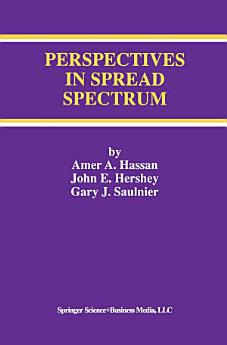Perspectives in Spread Spectrum
2012年12月 · The Springer International Series in Engineering and Computer Science 第 459 冊 · Springer Science & Business Media
4.0star
2 則評論report
電子書
163
頁數
report評分和評論未經驗證 瞭解詳情
關於這本電子書
Perspectives in Spread Spectrum brings together studies and recent work on six exciting topics from the spread spectrum arts. The book gives a wide, collective view of trends, ideas, and techniques in the spread spectrum discipline, due to the authors' extensive work on spread spectrum techniques and applications from different vantage points. The inexorable march of electronics towards ever faster, ever smaller, and ever more powerful electronic and optical circuitry has wrought, and will continue to enable, profound changes in the spread spectrum arts, by allowing increasingly complex signalling waveforms and statistical tests to be implemented as the theory beyond spread spectrum continues to evolve.
Perspectives in Spread Spectrum is divided into six chapters. The first chapter deals with sequence spreading design. There is not a single metric for design of spreading sequences; rather, the design is ideally tailored to the specific scenario of usage. This chapter delves into recent and very promising synthesis work. The second chapter deals with OFDM techniques. As channels become wider and trans-channel fading (or jamming) becomes frequency selective across the band, OFDM techniques may provide a powerful alternative design perspective. The third chapter is a generalization of the venerable Walsh functions. A new modulation scheme, Geometric Harmonic Modulation, GHM for short, is reviewed and characterized as a form of OFDM. From GHM, a further generalization of the Walsh functions is derived for non-binary signalling. The fourth chapter is concerned with some new and exciting results regarding the follower jammer paradigm. A counter-countermeasure technique is reviewed, notable for its counterintuitive characteristic which can be understood from a simple yet elegant game framework. The fifth chapter recounts some results pertaining to random coding for an optical spread spectrum link. The technique is based on laser speckle statistics and uses a coherent array of spatial light modulators at the transmitter but allows the receiver to be realized as a spatially distributed radiometric and therefore incoherent structure. The sixth and final chapter looks at an important and interesting application of spread spectrum to accurately locate a wideband, ‘bent pipe’, satellite transponder. It is, in a strong sense, an inverted GPS technique.
Perspectives in Spread Spectrum serves as an excellent reference and source of ideas for further research, and may be used as a text for advanced courses on the topic.
Perspectives in Spread Spectrum is divided into six chapters. The first chapter deals with sequence spreading design. There is not a single metric for design of spreading sequences; rather, the design is ideally tailored to the specific scenario of usage. This chapter delves into recent and very promising synthesis work. The second chapter deals with OFDM techniques. As channels become wider and trans-channel fading (or jamming) becomes frequency selective across the band, OFDM techniques may provide a powerful alternative design perspective. The third chapter is a generalization of the venerable Walsh functions. A new modulation scheme, Geometric Harmonic Modulation, GHM for short, is reviewed and characterized as a form of OFDM. From GHM, a further generalization of the Walsh functions is derived for non-binary signalling. The fourth chapter is concerned with some new and exciting results regarding the follower jammer paradigm. A counter-countermeasure technique is reviewed, notable for its counterintuitive characteristic which can be understood from a simple yet elegant game framework. The fifth chapter recounts some results pertaining to random coding for an optical spread spectrum link. The technique is based on laser speckle statistics and uses a coherent array of spatial light modulators at the transmitter but allows the receiver to be realized as a spatially distributed radiometric and therefore incoherent structure. The sixth and final chapter looks at an important and interesting application of spread spectrum to accurately locate a wideband, ‘bent pipe’, satellite transponder. It is, in a strong sense, an inverted GPS technique.
Perspectives in Spread Spectrum serves as an excellent reference and source of ideas for further research, and may be used as a text for advanced courses on the topic.
評分和評論
4.0
2 則評論
為這本電子書評分
請分享你的寶貴意見。
閱讀資訊
智能手機和平板電腦
手提電腦和電腦
你可以使用電腦的網絡瀏覽器聆聽在 Google Play 上購買的有聲書。
電子書閱讀器及其他裝置
如要在 Kobo 等電子墨水裝置上閱覽書籍,你需要下載檔案並傳輸到你的裝置。請按照說明中心的詳細指示,將檔案傳輸到支援的電子書閱讀器。









